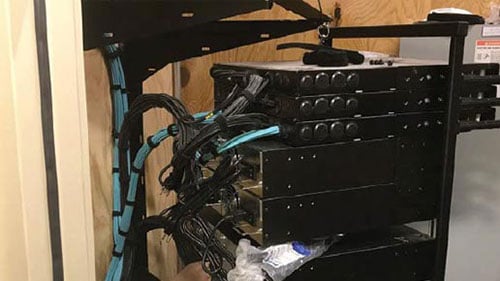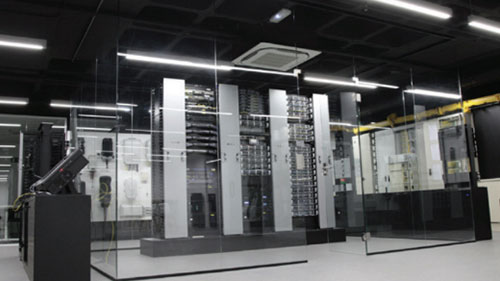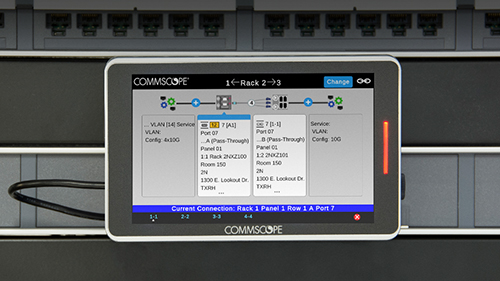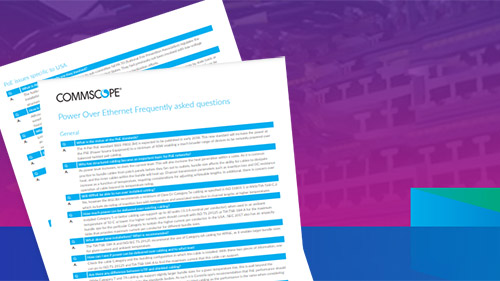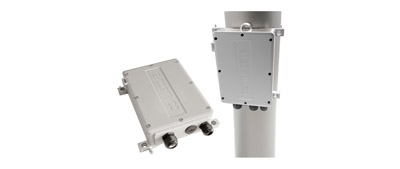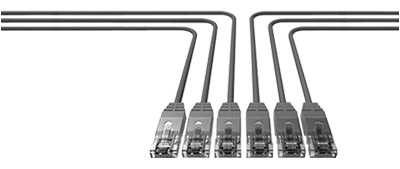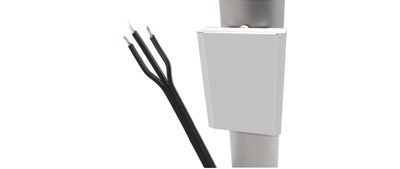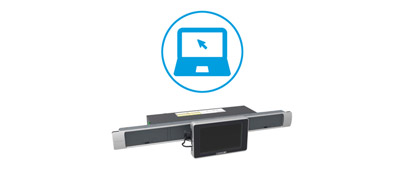Power over Ethernet (PoE): the Fact File
The proliferation of IP-connected network devices in the enterprise has not only driven the need for faster data rates, but also increased power. This has thrown the door wide open for power over Ethernet (PoE).
PoE allows connected devices to share data and power connectivity over a single copper Ethernet cable—streamlining infrastructure and simplifying operations. While PoE has been part of the enterprise network since 1999, its capabilities and importance have taken big leaps forward in recent years with the development of higher-wattage PoE devices. These devices include common enterprise fixtures such as desktop telephones, security cameras, video monitors and wireless access points for Wi-Fi or in-building wireless services, among others.
With today’s advanced PoE technologies and devices, enterprise networks no longer need to run a separate ac (alternating current) power feed to every connected device. And that’s just the beginning. The benefits of PoE also include better-designed electrical safety features, better device management and lower cost of installation and maintenance.
Whether it’s Wi-Fi access points, security cameras, LED lighting, IP phones, RFID security or building management systems, the increasing range of PoE devices means there is a great opportunity for the Enterprise to leverage remote power and better manage infrastructure-related expenses while using existing cabling. Learn how, now.
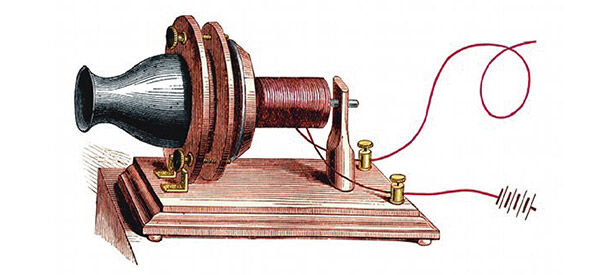
Powering of telecommunication devices over twisted-pair cabling is as old as the telephone
Would you like to read offline?
Download a PDF version of this article to read again later.
Stay informed!
Subscribe to The Enterprise Source and get updates when new articles are posted.
What is PoE and how does it work?
PoE1 is a system for safely transmitting electrical power and data to remote devices using standard Ethernet cabling, Category 3 and higher. PoE works by converting the mains power supply into a low-voltage supply, then transmitting the power over structured cabling to PoE-enabled devices. The system is designed to prevent data and power signals from interfering with each other. Power is transmitted on the data conductors by applying a common voltage to each pair. Because twisted-pair Ethernet uses differential signaling, this does not interfere with data transmission. As a result, PoE is able to transmit both power and data signals without disrupting the data signal.
While signal interference is eliminated, some power dissipation is inevitable. For example, systems meeting the PoE 802.3af-2003 standard introduce 15.4 watts of power on the cabling, but only 12.95 watts can be expected to be received by the powered device. The good news is that, as PoE-connected devices evolve, the industry standards needed to support them have evolved as well. See Chapter 4.1 for more.
By using communications cabling to deliver remote power, PoE enables cost-effective power delivery to a wide range of devices. Other advantages include:
- Smaller size of cables and connectors (versus ac line power) enables higher density
- Continuous monitoring of the circuit for faults and other operating conditions
- Low-voltage cabling can be installed as part of the ITC network for safer, lower-cost installations
- Improved control and operation of devices for better facility management
- Synergies between power delivery and communications enable intelligent infrastructure
- UPS backup, enabling robust and reliable operation
A PoE system consists of the power sourcing equipment (PSE), which supplies the power, and the powered device (PD), which receives the power. Where the PSE is located within the circuit determines the type of PoE configuration. Typically, PoE solutions are designed as end-span or mid-span.
In an end-span PoE solution, the PSE is typically built into the Ethernet switch port, placing it at the beginning of the link with the powered device located at the other end; thus, the power travels the length of the circuit. One end to the other—end-span.
The benefits of an end-span configuration include ease of management. You basically have one device to manage: the switch. Of course, if that switch doesn’t support your PoE power needs, you’ll need to decide whether to replace it or not.
Another key benefit of an end-span is service continuity in case of a power outage. Most LAN switches today integrate an uninterruptable power supply (UPS). During a power failure, the UPS kicks in to feed the end-span PSE and ensure continuous operation until power is restored.
As mentioned earlier, as the power signal travels along the link, it loses energy. For some long PoE hops, an end-span design simply can’t support the distance and power requirements of the device(s) you need to power. In that case, you’re better off with a mid-span design.
As the name implies, a mid-span PoE places the PSE somewhere between the Ethernet switch and powered device. To do this, it separates the power source from switch—creating a power injector that can be spliced into the link without disrupting the existing data signals. For this reason, mid-spans are commonly referred to as PoE injectors. A mid-span PSE can be used as a standalone power source, as shown in Figure 1.
Figure 1: Power from LAN equipment with end-span PSE (top) and a mid-span (bottom)

A mid-span PoE solution can further be sub-divided into single-port PoE injector or multi-port injector. A single-port injector is used to provide power to a single device. It is preferred in situations where there aren’t enough PoE devices to warrant the cost of a PoE switch, or if the data needs to first be transmitted a long distance (e.g., via fiber), before being converted back to copper cabling, and then have PoE applied.
The multi-port PoE injector (mid-span) was developed to “inject” power into an existing Ethernet network where the Ethernet switch does not provide PoE capability. The multi-port PoE injector box sits between an existing Ethernet switch and the PoE devices.
A key benefit of using a mid-span versus end-span solution is the ability to power devices located far away from the switch. A mid-span also enables you to keep the switches you have, regardless of their ability to support PoE. The downside is that, with a mid-span solution, you need to install and manage an extra device, the injector—increasing cost and resources.
The PDs are at the receiving end of the PoE distribution system and operate on low-voltage direct current (dc). Many PDs also feature an integrated PoE splitter, which separates the power and data signals for redistribution to other devices. When used in VoIP, wireless LAN and IP security applications, a PoE system can save up to 50 percent of the overall installation costs by eliminating the need to install separate electrical wiring and power outlets.
There is a wide variety of powered devices that are being deployed across enterprise networks. With the adoption of PoE++ and its 90-watt capabilities, the list is rapidly expanding.
Figure 2: Major PoE technology advances and supporting standards

Here are just a few of the device types:
Wireless access points: PoE-compliant wireless access points can make Wi-Fi network installation a piece of cake. Just pull a single Ethernet drop to the AP installation location, then connect the AP at one end and a PoE switch at the other.
Network switches: Small PoE-powered network switches are a slam-dunk in “edge-of-network” installations. Locate them in small racks or offices where an installer may need to connect five or six devices.
Security cameras and NVRs: Security cameras can be PoE-powered, greatly simplifying installation, especially in locations where power is difficult to access. PoE+ switches can power even the most power-hungry PTZ (pan-tilt-zoom) cameras.
IP speakers: IP speakers are a new type of VoIP device best suited for paging and notification applications. PoE’s digital cabling is perfect for carrying multiple streams of high-quality audio and its flexible wiring simplifies installation and system operation.
IP telephony: PoE-powered VoIP phones are nothing new but the technology continues to mature, delivering advanced connectivity. Beyond simplified cabling, PoE offers the advantage of IT staff being able to remotely power-cycle phones that need to be rebooted to restore functionality.
Digital signage/display boards: Digital signage is increasing in popularity, and PoE enables installers to capitalize on this growing market. Now, PoE-powered digital displays are taking things a step further with highly interactive and more functional features and performance.
Lighting: A surprising new application for PoE is lighting. It’s not a new idea, but there are some unique LED-based PoE lighting products available.
And much more: There is a wide variety of other PoE devices available, including access control keypads, synchronized clocks, message boards, video encoders to convert traditional analog camera outputs to IP, thin client PCs, and much, much more
PoE applications, markets and trends
According to the technology research and consulting firm The Building Services Research and Information Association (BSRIA), “worldwide PoE shipments are expected to grow at a compound annual growth rate (CAGR) of around 11-13% until 2023, exceeding 180 million ports sold yearly by the end of the period.”2
The broad market acceptance is the result of a perfect storm, in which advancing PoE capabilities coincide with an explosion in smart building/smart city deployment. In its report, BSRIA notes: “The growth in PoE deployment is being driven mainly by the convergence of several technology and socio-political trends, including smarter buildings, higher levels of energy efficiency, greater mobility, the upsurge of IoT, energy and building regulations, the so-called Industry 4.0 and the massive adoption of LEDs."
Figure 3

The PoE market can be broken down into three major segments—commercial, industrial and residential—with the majority of growth coming from commercial and industrial applications. Growing popularity of the commercial power over Ethernet (PoE) device segment is attributed to increasing demand from the retail sector, healthcare sector and office buildings. Within each sector, PoE provides the common infrastructure to support a wide variety of powered devices: VoIP phones, access control systems, lighting controls, alarms, barcode scanners, RFID, clocks, IP security cameras, digital signage displays, computer monitors, PoS terminals, wireless access points, smart building sensors, building access control, fire detection systems, AV systems and more.
Table 1: Examples of the proliferation of PoE devices being deployed in various environments

Meanwhile, the industrial internet of things (IIoT) adds another significant dimension to PoE’s growth potential. As manufacturing, distribution, and logistics companies continue to extend their networks to the edge, they’re deploying massive amounts of low-powered sensors and controllers to help drive improvements in areas such as automation, quality control and processing. According to research from Verified Markets Research, Inc., “The Industrial Internet of Things (IIoT) Market was valued at USD 61.27 Billion in 2018 and is projected to reach USD 103.38 Billion by 2026, growing at a CAGR of 6.7% from 2019 to 2026.” This growth is further driving PoE adoption and development.
Residential PoE applications have also witnessed massive growth recently, with the steady uptake of IP-based home security, smart home appliances, automation controls and more. As a result of increasing demand for more powered and connected devices/systems, PoE market is set to exceed US$2 billion by 20253.
The evolution of PoE: standards, types and classes
The evolution of PoE technology mirrors the evolution of the devices it supports—from its precursor standard powering devices such as telephones, to the first PoE standard in 2003, to the latest IEEE 802.3bt standard4 that supplies at least 71 watts over structured cabling. It is not uncommon for the introduction of various connected devices to predate the standards.
Table 2: Operational characteristics of PoE by standard, type and class

IEEE 802.3af (2003): Known simply as PoE, this first PoE standard provided up to 15.4 watts (dc) power using two of the four pairs in 10/100/1000BASE-T networks. PoE solutions that met this standard are also referred to as Type 1, as they were initially designed to support low-power (15 W) devices. Early Type 1 applications included IP clocks, VoIP phones and simple security cameras.
IEEE 802.3at (2009): the second generation of PoE (Type 2) is known as PoE+. It extended the IEEE802.3af standard to provide more dc power to PDs. The maximum PSE output for Type 2 PoE is 30 W, with a minimum PD input of 24.4 W. this makes PoE+ good for applications such as higher-powered LED lighting. PoE networks that comply with IEEE 802.3at standard are also backward compatible with the earlier 802.3af standard.
IEEE 802.3bt (2018): PoE++ is the most current PoE standard and the first to specify use of all four twisted pairs* to support the 2.5G/5G/10GBASE-T network. The standard defines two types of PoE—Type 3 and Type 4—that supply up to 60 W and 100 W, respectively. The IEEE 802.3bt standard supports legacy 10 Mbps, 100 Mbps and 1 Gbps as well as 2.5, 5 and 10 Gbps connectivity. It also supports power scaling between Ethernet switches and connected devices—even allowing unused devices to remotely power down for increased energy efficiency.
*In 2011, Cisco introduced its proprietary Universal Power Over Ethernet (UPoE), which extended the IEEE 802.3at standard to use all four cabling pairs to supply up to 60 watts power. While UPoE remains a non-standardized technology, it is still used in many cases.
As the requirements for powered and connected devices have steadily increased, it has become necessary to further classify PoE applications and solutions based on their power profiles. The two key metrics to consider in categorizing PoE are how much power the PSE can generate and the minimum amount of power the PD needs to operate. As mentioned earlier, the dc power signal from the PSE dissipates as it traverses the copper conductor. Therefore, the power from the PSE must exceed the minimum required power at the PD by a specified amount.
Based on these metrics, the industry has defined eight different power classes based on PSE output and PD input. Figure 4 indicates the power profiles for the types and classes of various PoE. *
*Note: The four types in Figure 4 refer to the evolutions in PoE development as defined in the approved standards. (See PoE Standards Development above.)
Figure 4: Types and classes of PoE application

PoE cabling design and deployment
Over the past decade, PoE has been seen as a key powering strategy—allowing network managers, installers, and integrators to use structured cabling to provide both power and data to many of their network devices. While the ability to run low-voltage power and data over the same cable could significantly simplify deployment and management of PoE networks, planning and designing them to achieve the best balance of cost, performance and manageability can be tricky. Engineers must consider several key variables. Key factors that affect and influence the efficient design and operation of your PoE network include:
- Channel topology: cable pathway infrastructure
- Managing thermal loads: cable bundling, spacing and lengths
- Selection of cables, cords, and connectors
With regard to channel topology, the four-pair PoE++ standard addresses power distribution to PDs via existing cabling types that have up to four twisted pairs and are up to 100 meters in length. For detailed information regarding the various topologies for supporting four-pair PoE, refer to ISO/IEC 11801 Generic Cabling for Customer Premises, ANSI/TIA-568-C.2 Balanced Twisted-pair Telecommunications Cabling and Component Standard, and the CENELEC EN 50173 series of Information Technology Generic Cabling Systems.
According to the current scope of the four-pair PoE discussion, all cabling must (at minimum) meet the performance requirements for Category 5e cabling over a 100-meter channel, including a worst-case scenario of four connections. It should be noted that Category 5e cabling only provides the minimum level of performance required.
Therefore, it is recommended to use Category 6 or Category 6A cabling—preferably, solutions such as CommScope’s GigaSPEED® XL® or GigaSPEED X10D® that have been tested for compliance to the corresponding category or class per ANSI/TIA-568 and ISO/IEC 11801, and CENELEC EN 50173 series of standards.
In a traditional network cabling topology, PoE outlets are directly connected via horizontal cables to the patch panel in the floor’s telecommunications room. For many installations involving four-pair PoE, especially new installations, a cabling approach known as the universal connectivity grid (UCG) can provide easier cable routing and greater flexibility.
With the UCG design concepts, the ability to easily accommodate moves, adds and changes by simply connecting the PD to a zone distributor saves labor and materials—lowering initial CapEx installation costs and ongoing OpEx. The TIA-862-B, CENELEC EN 50173-6 and the ISO/IEC draft 11801-6 standards describe a similar design concept. They both focus on non-user-specific applications, many of which use PoE.
The UCG model, as shown in Figure 5, uses cable runs from the equipment room to specific “building zones.” A consolidation point (CP) within each zone allows fixed cabling to be installed up to the CP; drop cabling then runs from the CP to the outlet for each PD. This approach provides additional flexibility in cabling from the CP to the first TO in each cell, as well as providing spare capacity for additional TOs as needed.
Ideal for new installations, this strategy can also be helpful during retrofit installations, where well-placed CPs allow long runs of cabling bundles from the telecommunications room to be fixed into difficult pathways. Once the fixed cabling is in place, installers have more flexibility in running and changing extension cable from the CP to the TO serving the PDs for data and intelligent building equipment.
Helpful industry standards
Refer to the following standards for guidance on designing and deploying PoE networks.
TIA TSB 184-A Guidelines for Supporting Power Delivery Over Balanced Twisted-Pair Cabling
ISO/IEC TS 29125 Information Technology—Telecommunications Cabling Requirements For Remote Powering Of Terminal Equipment
CENELEC CLC/TR 50174-99-1 Information technology—Cabling installation—Part 99-1: Remote powering
NEC NFPA 70 Code E TIA 569-2 Additional pathway and space considerations for supporting remote powering over balanced twisted-pair cabling
ISO/IEC 14763-2 revision including remote power planning and installation (in development)
Figure 5: Zone cabling using consolidation points

To minimize cooling costs and maximize the usable lifespan of the cabling infrastructure, it is important to consider the thermal load on the cabling. When remote power is applied to balanced cabling, the temperature of the cabling will rise due to heat generation in the copper conductors. More current means more heat—and that limits the number of cable runs allowed in a single bundle. So too, longer distances mean greater cumulative resistance, which further increases the temperature.
Figure 6 illustrates the worst-case relationship between current (expressed in milliamps) and the thermal load on wire pairs of varying categories within a 37-cable bundle.
The IEEE 802.3bt four-pair PoE standard assumes a maximum temperature rise of 10 degrees Celsius when all four pairs are energized. For cabling with an operational temperature range of -20 degrees Celsius to 60 degrees Celsius, the ambient temperature should not exceed 50 degrees Celsius. Using a higher category cable with lower dc resistance and improved heat dissipation is one way to help reduce the rise in temperature.
Figure 6: Effects of dc current on cable temperature

Two other important variables that contribute to high thermal loading are size and spacing of each cable bundle. The ISO/IEC 14763-2, ISO/IEC TR 29125, CENELEC TR 50174-99-1 and the TIA-TSB-184-A cabling installation standards recommend cable bundles with 24 cables or fewer to allow for worst-case conditions regarding conductor gauge, powering and installation conditions. Based on extensive modeling and measurement work done during the development of CENELEC TR 50174-99-01 and TIA TSB 184-A, the recommended bundle size is 24 cables.
The 24-cable bundle size is a recommendation from the applicable standards, not a requirement—but should be followed as a general rule. Sometimes, larger bundle sizes may be needed; a qualified designer/installer can make the necessary evaluation to determine if a bundle size will cause any overheating. Tables in the appropriate TIA, ISO/IEC and CENELEC cabling standards on remote powering implementation provide a mechanism to check if a particular cable category bundle size is acceptable. For a given ambient temperature and installation condition—if the current per pair is greater than the maximum current on the PoE port—the cable bundle size is acceptable.
To determine the maximum current that will not exceed the temperature rating of a 60 degree Celsius rated cable, a designer/installer can reference the information in Table 3 below. For example, if a 61-cable Category 6A bundle is installed in 45 degrees Celsius ambient temperature, the maximum current is 1.162 amps in air and 1.008 amps in conduit, which is more than the 0.96 maximum current that IEEE 802.3bt equipment will source. Therefore, the 61-cable Category 6A bundle can easily support all IEEE 802.3 PoE applications at 45 degrees Celsius ambient. Additionally, it should be noted that these current capacities in IEEE 802.3bt are for a worst-case 100-meter 24-AWG cabling with a loop resistance of 25 ohms. With higher performing cables, bundle sizes can often be increased over shorter distances and gauge sizes reduced. For reference, Category 6A uses a 23 AWG conductor.
Smaller bundles can help to reduce the thermal load

Table 3: Current capacity per pair at 45˚ C ambient temperature for a category of cable versus number of cables in bundle for standard 60˚ C rated cables

It should also be noted that, given the higher power levels associated with four-pair PoE (4PPoE), specific cabling infrastructure and cable bundles should be managed to ensure adequate heat dissipation. For example, installation in conduit degrades thermal performance—with a higher temperature rise than open-air installation. Conduit installation should be minimized to only those areas mandated by the local authority having jurisdiction (AHJ), using a maximum fill percentage of 40 percent and maximum bundle sizes of 24 cables per bundle.
The spacing between bundles in the pathways also affects the overall thermal load on all bundles. During laboratory testing, CommScope engineers observed the following:
- When bundles are separated by 0.3x of the bundled diameter, they heat up like a single bundle.
- A single 24-cable bundle of SYSTIMAX® GigaSPEED X10D heats up 5 degrees Celsius when energized, while five 24-cable bundles of SYSTIMAX GigaSPEED X10D rises by 14 degrees Celsius.
- When the five 24-cable bundles are arranged side-by-side without air gaps, they each increased in temperature by 14 degrees Celsius. By spacing the same bundles by 0.66x, the bundle diameter, the temperature rise was limited to 10 degrees Celsius.
- When the number of 24-cable bundles was increased to nine and arranged with no air gaps between them, the result was an increase in temperature of 22 degrees Celsius. By spacing the same bundles by 0.84x the bundle diameter, the temperature rise was reduced to 19 degrees Celsius.
Factors impacting the thermal load

As Table 4 illustrates, as the channel length increases, so does the operating temperature. When operating temperatures exceed 20 degrees Celsius, one way to reduce the thermal load is to shorten the channel length. When planning the PoE network, CommScope recommends ensuring permanent links do not exceed 90 meters. The cabling channel performance and the reference implementation with 90 meters of fixed cabling plus 10 meters of cords are based on 20 degrees Celsius operating temperature.
This model assumes same temperature along the whole length of the cabling. If needed, the temperature for each cable segment can be calculated according to the specific ambient temperature and bundle size.
Because increased thermal loading can also increase insertion loss, CommScope also recommends the maximum cable length be de-rated for higher temperatures. This is per ANSI/TIA-568-C.2 Balanced Twisted-pair Telecommunications Cabling and Component Standard, or alternatively the ISO/IEC 11801 or CENELEC EN 50173 series standards.
Table 4: Technology-independent channel length vs. temperature

The maximum continuous output current from the PSE under normal mode—over one pair or 480 milliamps (mA) dc per conductor—is 1920 mA dc. This represents the maximum allowable current for the 802.3bt standard. The cabling solution you select should meet or exceed this requirement.
CommScope cabling systems go a step further, as they are guaranteed to support all the implementations defined in all of the IEEE PoE standards. Although not standardized, Cisco’s UPoE implementation is also supported. IEEE 802.3 PoE and Cisco’s UPoE are covered by the CommScope Extended Product Warranty and Application Assurance Program, when deployed in a certified CommScope installation that meets the relevant design and installation guidelines.
Table 5: Current capacity per pair at 45 degrees Celsius ambient temperature for a category of cable versus number of cables in bundle

CommScope’s advice is to deploy Category 6A cable, especially for four-pair PoE applications, and include two cable runs per connected device. This ensures maximum headroom for future growth and doubles the number of zone distributions available in the future. It’s technically easy to justify the choice of Category 6A for PoE purposes. The higher the Category, the higher the supported currents and, as seen previously, a better endurance to the heating of the bundle, so it will perform better at long distances.
If connectors are unplugged under load, an inductive current is created within the connector that may spark at one or more contact surfaces—causing the surfaces to corrode. When the connectors are de-mated, the arcing may degrade the communication over the connecting hardware. EN 60512-99-001 and IEC 60512-99-002 provide test standards for assessing the possible damage from de-mating under load.
By designing the contact area away from the arcing area, as in CommScope’s lead-frame design shown in Figure 7, the arcing will not affect the critical contact area. Thus, the outlets can reliably support the IEEE 802.3bt 4PPoE applications.
Figure 7: CommScope lead-frame design locates the arcing area safely away from the contact area
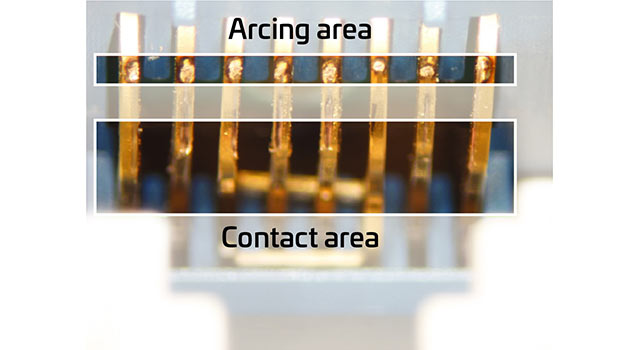
Contrary to popular belief, wireless networks require wires. Recently, cabling to support wireless applications has improved significantly. Today’s Category 6A is quickly becoming the default for new in-building wireless and Wi-Fi systems. Category 6A pairs well with 10GBASE-T LAN technology and remote powering; it also supports multi-operator, multi-technology coverage and capacity solutions.
Which Category? How many cables per AP?
As mentioned, Category 6A is preferred for its higher bandwidth and power-handling capacity over a lower category. Choosing a lower Category Ethernet puts you at risk of having to replace your cabling in a few years should your power needs increase.
Today’s 802.11ax (Wi-Fi 6) access points can have a maximum speed of 6.77 Gbps. Supporting that speed requires a 10GBASE-T connection. CommScope’s recommendation (as well as BICSI’s) is to provide two Category 6A cables per AP. This will ensure the ability to support future growth or new, more powerful AP devices, as they become available. The ISO/IEC 11801-6 and ANSI/TIA 162-A also recommend two Category 6A cables per Wi-Fi AP zone.
Figure 8: RUCKUS® R850 access point

Monitoring PoE distribution over structured cabling
As we have seen, cabling standards in TIA, ISO/IEC and CENELEC establish recommended cable bundle sizes based on environment and cable categories. Addendum 1 of the ISO/IEC 18598 (AIM standard) addresses the need to document cable bundle sizes and the power levels of each cable in the bundle.
An automated infrastructure management (AIM) system such as CommScope’s imVision® solution can automate such recordkeeping to ensure standards-compliant designs are documented. It does this by correlating the real-time switch power usage per port with cable bundle size and cable type as shown in Figure 9.
Figure 9: Documenting bundle sizes and power levels using imVision automated infrastructure management solution

The number of cables in a bundle is a static number; however, the status of the PoE and data cabling changes. This is due to the dynamic nature of the connectivity between switch and panel ports. Whenever connectivity changes are made, imVision automatically updates the cable status within a cable bundle, thus providing a real-time view of every cable bundle’s PoE state.
Most of the guidelines in cabling standards define a maximum cable bundle size based on the most demanding scenario of having all cables in a bundle delivering PoE Class 8 current (90 watts), as defined by the IEEE 802.3bt standard.
However, in practice, not every cable in a bundle could be energized—or, if it is energized, it may not be to the level of PoE Class 8 current. Because imVision automatically monitors the PoE state of each cable within a bundle in real time (Figure 10), bundle sizes do not have to be constrained by the maximum size per the guidelines. Instead, imVision provides the flexibility to use whatever bundle size is suitable for that installation.
imVision also provides unique standards-based management of cable bundle sizes, which has become increasingly important as higher power PoE standards have been developed. The advantages of PoE monitoring, recording and documentation become increasingly important as both the number and types of PoE-enabled devices in the enterprise continue to increase. Several factors are driving this, including:
- 4PPoE standard (IEEE P802.3bt) that provides for up to 90 watts to end devices
- Convergence of IT and facility networks onto a common IP/Ethernet platform
- The internet of things (IoT) and its ever-growing ecosystem of connected devices
Figure 10: imVision displays the PoE state of each cable in a bundle in real time

In its R&D lab in Greensboro, NC, CommScope is trialing next-generation PoE applications to verify the performance and safety of the structured cabling systems that support them. Of particular concern is their thermal performance in different real-world installation conditions. In addition, the lab hosts demonstrations of next-generation PoE applications, such as high-definition security cameras, in-building wireless systems and digital signage in collaboration with ecosystem partners.
CommScope’s new lab opened as the Institute of Electrical and Electronics Engineers approved the new four-pair PoE standard (4PPoE) known as IEEE 802.3bt, which enables higher-power device connections of up to about 90 watts at the power source equipment. As more power can be delivered by PoE switches, more research is needed to verify the impact to structured cabling of a variety of installation conditions. Some of the new PoE applications that may be trialed include:
- High-tech security cameras with advanced features like zoom and facial recognition
- PoE-powered computers, thin client devices and digital signage
- In-building wireless systems
- LED lighting systems
- Building management systems incorporating security, lighting, HVAC control, in-building wireless and access control
- Internet of things networks
Throughout the development of the new IEEE standard, CommScope has been sharing test results with standards bodies on the theoretical challenges in the new higher power delivery. For its initial research in the new lab, CommScope is trialing equipment from Cisco, Signify (formerly Philips Lighting) and Thinlabs. The purpose is to demonstrate a smart office building scenario with lighting, security cameras and LAN switches connected via 4PPoE on SYSTIMAX cabling. CommScope engineers analyze the cable’s heat emissions in a real-world setting with cables installed in ceilings and through walls while running high-power applications.

Video: CommScope Opens Power over Ethernet Lab for Research
Testing equipment at CommScope’s PoE lab



Conclusion
The recent introduction of new connectivity options—Wi-Fi 6, 5G, shared spectrum and more—has helped increase the deployment of converged IoT and OT edge devices such as IP security cameras, LED lighting and 4K/HD digital signage. Additional edge devices include point-of-sale units, along with intelligent building management systems and sensors such as access control (smart locks), location services, fire detection and evacuation. Meanwhile, 5G-enabled smart home systems are beginning to gain real traction in the market, as well. Due to its efficiency, versatility and safety, power over Ethernet (PoE) is the preferred technology for delivering power to these connected edge devices, wireless access points and more.
The latest 802.3bt power over Ethernet standard (also known as four-pair PoE or simply 4PPoE) stipulates support for a full 90 watts, deliverable via Category 6A cabling. Although older wireless access points (APs) tend to draw a minimal amount of power, some newer APs require more power to drive all their radios and provide power for devices connected via their USB ports. The number of PoE-enabled edge devices—such as HD/4K digital signage; pan, tilt and zoom (PTZ) cameras; and smart LED lighting—is expected to continue to increase in the coming years.
PoE will likely also be considered as increasingly important as a stable backup power source for converged edge devices where uptime is critical. For example, an HD camera may feed data to multiple applications such as security systems, people counting, machine learning (ML) analytics and occupancy sensors. By combining and centralizing power and data at the network switch with dedicated power circuits, PoE simplifies and automates troubleshooting and management.
Yet, even as it simplifies and streamlines the network infrastructure, designing a PoE network that provides the best balance of performance, cost efficiency, reliability and scalability is anything but simple.
In the preceding chapters, we’ve provided an overview of some of the key concepts and considerations, which might be helpful to keep in mind as you design, grow and integrate your PoE system into the broader enterprise network. Admittedly, this is a high-level overview. We hope you will take advantage of the links to other assets that afford a deeper dive into specific issues.
And, as always, you’re never alone; CommScope is here to help guide and advise you—helping you plan and prepare for what’s next.
Laying the groundwork for a new level of Power over Ethernet
An overview of PoE technology that explains the status of standardization efforts and key guidelines and recommendations to ensure that your cabling infrastructure is capable of supporting PoE.
1 IEEE 802.3bt-2018 - IEEE Standard for Ethernet Amendment 2: Physical Layer and Management Parameters for Power over Ethernet over 4 pairs
2 BSRIA Expects Fast Growth on Power over Ethernet Applications
3 Global PoE Solutions Market Size to exceed $2bn by 2025; Global Market Insights, Inc.; May 2019
4 IEEE 802.3bt-2018 - IEEE Standard for Ethernet Amendment 2: Physical Layer and Management Parameters for Power over Ethernet over 4 pairs
What’s Driving the Future of PoE?
Power over Ethernet advances go beyond more powerful network switches and support for in-building wireless. Learn what's in store for your network's PoE future.
